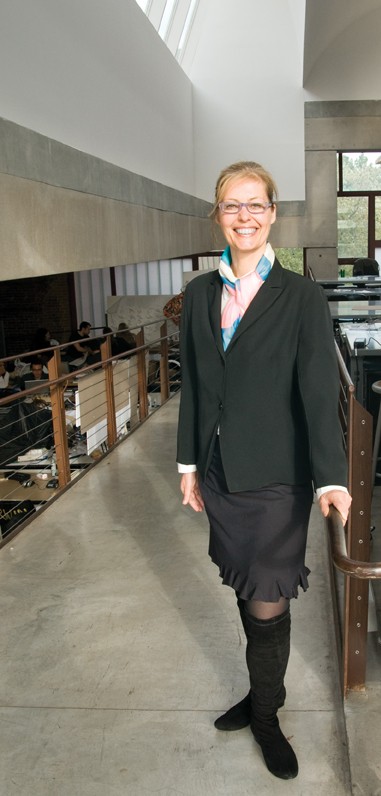Faculty Focus
The Professor: Meta Brunzema
The Course: Transition Studio 2.0
 Adjunct Associate Professor of Graduate Architecture and Urban Design Meta Brunzema
Adjunct Associate Professor of Graduate Architecture and Urban Design Meta Brunzema
Adjunct Associate Professor Meta Brunzema’s fifth-semester graduate architecture course challenges students to design a project based on a new theoretical framework called “transition management,” which says that undertaking multiple innovations at different scales can accelerate a city’s social, technological, and cultural change.
In the Transition Studio, students focus on a post-industrial, economically depressed region and propose projects designed to retain and attract businesses and population and reenergize the community. The most recent Transition Studio focused on Poughkeepsie, about 80 miles from New York City.
What kind of future do you envision for Poughkeepsie and other cities that have experienced severe economic decline with the collapse of manufacturing in the U.S.?
The overarching idea for reenergizing such cities is that government alone can no longer do it all. We need to tap into the energy of people and businesses and let them undertake a wide range of projects in conjunction with their municipalities. There also needs to be experimentation with urban design and architecture to help catalyze these changes.
What are some ways to revitalize these post-industrial factory towns?
In my most recent Transition Studio we created an area called the Pioneer District in a large quarry in Poughkeepsie—a rapid economic development zone.
All of the students’ design projects attempted to facilitate collaboration and communication, and engage people actively with their environment. Each project was also designed to adapt to rapidly changing economic circumstances. Among the projects the students designed were a mixed-use business district, an industrial production and innovation complex, and housing plans. One student designed an interactive facility where municipal waste is transformed into new soil and products as part of a new type of public-private partnership.
Why did you have your students focus on Poughkeepsie?
Poughkeepsie is historically and economically typical of many towns in the Hudson and Erie Canal valleys. Also, it’s outside of the area from which people typically commute to work in New York City, which was important for our purposes, because having commuters distorts the city’s overall economic picture.
However, Poughkeepsie is also a city with wonderful potential. There are beautiful buildings and a lot of energetic people invested in improving their community.
The students’ work was conceived in the framework of a proposed regional plan called “Building Exhibition Hudson Valley/Erie Canal 2014–2024,” which seeks to create hundreds of projects through creative competition between towns, businesses, or civic groups in partnership with the public sector. The idea is that these towns will ultimately work together as a network of polycentric regional towns rather than isolated suburbs and town centers.
What first interested you in this kind of work?
This kind of work expands on simply designing buildings; instead this experimental architectural design process is meant to transform larger urban systems—the economy, education, building, culture, and more. Pratt is the ideal place to teach such a course because of its richness of people and resources and a strong commitment to systemic and trans-disciplinary design.
Text: Abigail Beshkin
Photo: Diana Pau

 Gateway Editors
Gateway Editors
Reader Comments (1)
Perhaps with more projects like this, municipalities will begin to visualize tangible futures rather than rely on rhetoric to shape their cities and respond to problems.